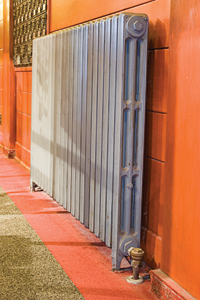
|
| Photo credit: ©istockphoto.com/wlfella |
Let’s get right to it with some steam-trap advice.
• If the F&T trap is the same size as the pipe, it’s the wrong size. I was checking the size of trap that was at the bottom of a 6-in. main that went up 35 stories in a building. The proper size for that trap would have been 1 1/4”. Of course, the trap that was in place was much larger and that’s the reason why it had failed. An oversized F&T trap barely opens to dump the little bit of condensate it has to handle. The trap’s pin rides too closely to the trap’s seat and that leads to metal erosion of both the pin and the seat as the condensate screams by the barely open exit hole. I asked the engineer why the trap was so large. He said that 1 1/4-in. would have looked stupid. Really.
In every case, when you see an F&T trap in a heating system and it’s the size of the pipe it serves, know that it is oversized. Someone paid too much and that oversized trap will fail.
But it will look good.
• All traps need Delta-P. Without a difference in pressure, a steam trap will just sit there like a metal meatloaf. You need Delta-P to go get the condensate to move through the trap. That’s why you’ll usually see traps mounted several feet below steam-to-water heat exchangers. When the exchanger’s control valve shuts, there’s no steam pressure to move the condensate out of the heat exchange. A vacuum breaker on the shell will open (and please make sure one is there) to let air into the shell. Then the static weight of the water between the outlet of the heat exchanger and the inlet of the steam trap will provide the pressure needed to move the condensate through the trap. It’s all about Delta-P.
• Beware of backpressure. Keep your eyes on the outlet side of that trap as well. Does the condensate have to go uphill from there? If so, there will be a check valve and backpressure. You’ll need to consider this when sizing the trap. Also, look at what else is connected to the outlet side of the trap. Are there other steam traps? At what pressure are they discharging? Are they working properly? Are they putting flash steam into the return line? That also will create backpressure. Open your eyes and look around.
• If you double-trap a return line, the condensate will barely move. Here again, think about Delta-P. Steam traps trap steam. If you double-trap a return line, there will be no pressure after the first trap to push condensate through the second trap. Remember, where there is no difference in pressure there can be no flow. So the condensate lies in the pipe and blocks the air that’s trying to vent. There’s no heat because if the air can’t get out, the steam can’t get in. Oh, and the boiler will probably go off on low-water because the condensate isn’t returning.
The automatic feeder will open to replace the water that’s not returning, and when the steaming cycle is over and the condensate finally does return, the boiler will flood. Or the feed pump’s receiver will overflow. And it’s all because of the double traps.
• Traps don’t vent air. Air moves through a trap and into the return line, but from there it has to have a way to get out of the system or the steam won’t go where you need it to go. If the discharge of the trap goes upward, that’s going to form a water seal. Air won’t vent through a water seal (think about a sink trap). And again, where there is air, steam will not go.
Think like air when you’re troubleshooting. Ask yourself, “If I were air, could I get out?” Follow the path of the air and look for the vents. If you don’t see them, that’s why the building isn’t heating well.
• Don’t use bucket traps near a pressure-reducing valve. To get a bucket trap to work you first have to prime it with water. When a pressure-reducing valve lowers the pressure of the steam, you wind up with superheat. That’s steam that’s hotter than it ought to be for the pressure that it’s at. Those extra Btu need to go somewhere, and they will gladly go into that bucket trap’s prime water and cause it to turn to steam and leave the trap. Without the prime, the trap will blow steam into the return lines. Not good, and this is why you’ll usually see thermodisc-type traps near PRV stations.
• Don’t trap lines that go to gravity wet returns. A gravity-return system is one that doesn’t have a condensate pump or a boiler-feed pump. If you have, say, a steam unit heater, its return line will need a big main vent to get the air out of the unit heater. That vent should be on the outlet side of the unit heater. But if the condensate is draining into a wet return, just let it fall by gravity into that line. There’s no need for a trap here because all the pipes below the boiler’s waterline are permanently under water. If you use a trap, it will cause condensate to back up into the unit heater. Also not good.
• Some traps let condensate flash back to steam. Particularly F&T traps because they don’t sense the temperature of the condensate. They dump condensate at saturated-steam temperature. That means some of the condensate will flash back into steam when it enters the return line. That causes backpressure, which can affect the operation of other traps. If the trap is near a vented boiler-feed-pump’s receiver, that flash steam will show up as puffs of steam coming out of the vent. That’s liable to cause some knucklehead to put a cap on the vent line. Lower the steam pressure to get rid of the flash steam. Most steam-heating systems are running at pressures that are too high anyway, so try lowering it.
• Radiator traps last about 10 years. In a typical year, a radiator trap will cycle about 175,000 times. That’s why, after about 10 years, they’re ready to retire. If the trap fails closed, there will be no heat and someone will notice. But if the trap fails open, that radiator will continue to heat and that person won’t complain. The steam, however, will now be in the return lines, causing backpressure on the other traps.
Those people will complain because if the air can’t get out of their radiators, the steam can’t get in. And air won’t go into a return line that has steam pressure in it. Ten years is what you get from a trap. If no one has ever looked at them, that’s probably where you’ll find the solution to the heating problem.
• Master traps make no sense. When traps go bad, some installers think they can solve all the problems by piping one enormous trap right at the inlet to the boiler-feed pump. They liken this spot to the trunk of a tree. They don’t understand why all those traps are out there on the tree branches. They don’t realize that radiator traps set up the points of pressure and no-pressure throughout the system.
In this way, they’re similar to balancing valves in a hot-water system. These installers think the Dead Men who first piped all those traps were stupid. Why would they have used so many traps when they could have gotten by with just one humungous trap down there in the basement? It seems so simple to them.
These installers are world-class idiots.




